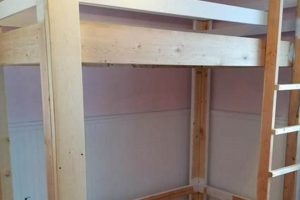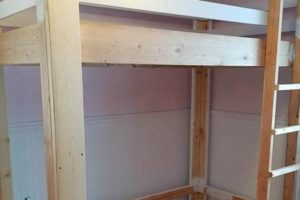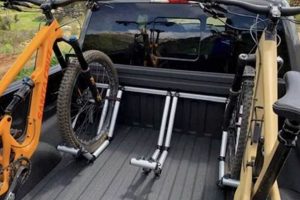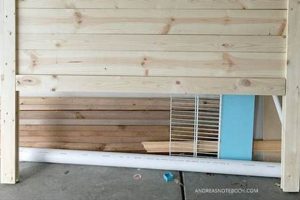A do-it-yourself truck bed sliding platform is a custom-built or modified structure installed in the cargo area of a pickup truck. It provides a movable surface that extends outward, facilitating easier access to items stored further inside the truck bed. This mechanism typically utilizes rollers, bearings, or tracks to enable smooth movement of the platform. For example, constructing one from plywood, metal framing, and heavy-duty drawer slides allows users to load and unload tools or equipment without fully climbing into the truck bed.
The construction and implementation of such a system offer significant advantages in terms of organization, accessibility, and ergonomics. By bringing items within easier reach, these platforms reduce the physical strain associated with accessing cargo. Historically, individuals seeking efficient cargo management solutions have adapted various sliding mechanisms for truck beds, reflecting a continuous need to optimize storage and retrieval in vehicular contexts. The benefits extend to improved time management and reduced risk of injury, particularly in professions requiring frequent access to bed-stored materials.
The following sections will detail the materials required, step-by-step construction processes, safety considerations, and potential design variations for building a functional and durable version of this cargo management system. Considerations for material selection, structural integrity, and ease of use are paramount in achieving a successful outcome.
Tips for Constructing a DIY Truck Bed Slide
The following provides practical advice for constructing a durable and functional do-it-yourself truck bed sliding platform, ensuring optimal performance and longevity.
Tip 1: Material Selection is Critical: Opt for marine-grade plywood or aluminum for the platform surface to withstand exposure to weather and heavy loads. These materials resist moisture damage and provide a stable base for cargo.
Tip 2: Invest in High-Quality Slides: Choose heavy-duty drawer slides with a high weight capacity rating, exceeding the anticipated maximum load. Full-extension slides provide complete access to the platform’s contents.
Tip 3: Accurate Measurements are Essential: Precisely measure the truck bed’s dimensions to ensure a snug fit and smooth sliding action. Account for any irregularities in the bed’s shape or obstructions.
Tip 4: Reinforce Key Structural Points: Strengthen the platform’s frame with metal brackets or corner braces, particularly at joints and stress points. This prevents warping or sagging under heavy loads.
Tip 5: Incorporate a Locking Mechanism: Implement a reliable locking system to secure the platform in both the extended and retracted positions. This prevents unwanted movement during transit and enhances safety.
Tip 6: Consider Surface Treatment: Apply a durable coating, such as bed liner spray or a non-slip sealant, to the platform surface to protect against scratches, corrosion, and slippage.
Tip 7: Ensure Proper Drainage: Design the platform with drainage holes to prevent water accumulation, which can lead to rust or material degradation. Position these holes strategically to avoid compromising structural integrity.
Implementing these suggestions will result in a truck bed sliding platform that enhances cargo management and minimizes the potential for damage or injury.
The subsequent sections will explore advanced design features and customization options to further tailor the platform to specific needs.
1. Material Strength
Material strength is a fundamental consideration in the design and construction of a do-it-yourself truck bed sliding platform. It directly influences the load-bearing capacity, durability, and overall lifespan of the system. Insufficient material strength can lead to structural failure, rendering the platform unusable and potentially creating safety hazards. For example, using thin-gauge steel for the frame, instead of thicker, reinforced profiles, may cause the platform to buckle or warp under a heavy load, such as tools or equipment. The selection of appropriate materials, therefore, is a critical determinant of the platform’s performance and reliability.
The practical significance of understanding material strength extends to the longevity and cost-effectiveness of the DIY project. Choosing materials that can withstand the anticipated loads and environmental conditions, such as weather exposure and abrasion, minimizes the risk of premature failure and the need for costly repairs or replacements. The proper selection necessitates evaluating the material’s yield strength, tensile strength, and resistance to corrosion, factoring in the specific application and the intended use of the platform. A common scenario involves using marine-grade plywood for the deck surface to prevent water damage, coupled with a robust steel frame to provide structural support.
In summary, material strength represents a core element of the overall design and construction of a do-it-yourself truck bed sliding platform. Its proper assessment and implementation ensures the platform’s safety, functionality, and durability, contributing to an efficient and reliable cargo management solution. The challenge lies in balancing cost considerations with the required strength characteristics, necessitating careful planning and material selection. The interplay between material strength and design ultimately dictates the success and long-term viability of the project.
2. Slide Capacity
Slide capacity is a critical engineering parameter in the context of constructing a do-it-yourself truck bed sliding platform. It represents the maximum weight a sliding mechanism can safely and reliably support without compromising its structural integrity or functionality. A proper understanding and implementation of slide capacity considerations are paramount for ensuring the safety and longevity of the system.
- Load Distribution and Slide Rating
The rated capacity of drawer slides used in the platform’s construction is typically based on a uniform load distribution. Concentrated loads, however, such as placing a heavy object directly in the center of the extended platform, can significantly reduce the effective slide capacity. For example, a pair of slides rated for 500 lbs. may only effectively handle 300 lbs. when the load is concentrated. Proper design mitigates this risk through reinforcement and strategic placement of support structures. Selecting a slide with a higher rating than the anticipated maximum load is a common practice to provide a safety margin.
- Material Selection Impact on Capacity
The materials used in the construction of the platform’s frame and deck directly impact the system’s overall slide capacity. A weak or flexible deck material, such as thin plywood, may deflect under load, transferring stress to the slides and potentially exceeding their capacity. Similarly, a poorly constructed or insufficiently reinforced frame can buckle, compromising the slides’ alignment and reducing their load-bearing ability. Therefore, robust materials, such as steel framing and thick-gauge plywood or aluminum decking, are essential for maximizing slide capacity and ensuring safe operation. For example, upgrading from ” plywood to 1″ marine-grade plywood can significantly increase the platform’s rigidity and load-bearing capability.
- Dynamic vs. Static Load Considerations
Slide capacity ratings typically refer to static loads, representing the weight the slides can support when stationary. Dynamic loads, which occur during acceleration, braking, and cornering, can significantly increase the stress on the slides. These dynamic forces can exceed the static load, potentially causing premature wear or failure. To account for these forces, it’s prudent to select slides with a higher capacity rating and implement design features that minimize movement and vibration. Securing cargo properly and using dampening materials can help mitigate the impact of dynamic loads on the system. An example is securing the platform to the truck bed using tie-down straps to minimize movement during driving.
- Environmental Factors and Capacity Degradation
Exposure to environmental factors, such as moisture, extreme temperatures, and corrosive substances, can degrade the materials and components of the sliding platform, reducing its slide capacity over time. Corrosion can weaken the slides and frame, while temperature fluctuations can cause expansion and contraction, affecting the alignment and performance of the system. Regular maintenance, including cleaning, lubrication, and inspection, is essential for mitigating these effects and preserving the platform’s slide capacity. Applying a protective coating to the metal components and using water-resistant materials can also help extend the lifespan of the system and maintain its load-bearing capabilities. Consider situations where the platform is constantly exposed to saltwater; stainless steel slides become essential for durability.
The proper assessment and implementation of slide capacity considerations are critical for ensuring the safety, reliability, and longevity of a DIY truck bed sliding platform. Failure to account for factors such as load distribution, material selection, dynamic loads, and environmental factors can result in premature failure, costly repairs, and potential safety hazards. A comprehensive approach to slide capacity assessment, coupled with meticulous design and construction practices, is essential for creating a system that meets the demands of its intended application.
3. Accurate Dimensions
The precision of dimensions is paramount to the successful construction and functionality of a do-it-yourself truck bed sliding platform. Deviation from accurate measurements can result in a poorly fitting structure, compromised sliding mechanisms, and ultimately, a non-functional or unsafe cargo management system. The following points highlight the crucial aspects of dimensional accuracy in this context.
- Truck Bed Geometry
Truck beds are often not perfectly square or uniformly shaped. Minor variations in width, length, and depth can exist due to manufacturing tolerances or previous damage. Accurate measurements, taken at multiple points within the truck bed, are essential to determine the precise internal dimensions. Failure to account for these variations can result in a platform that binds, rubs against the truck bed walls, or is unable to fully extend. A practical example is measuring the width at both the front and rear of the bed, as well as along the floor, to identify any discrepancies that need to be addressed in the platform’s design.
- Component Tolerances and Fit
The individual components used in the sliding platform, such as the slides, frame members, and decking material, all possess their own dimensional tolerances. The cumulative effect of these tolerances can significantly impact the overall fit and functionality of the system. For example, if the frame members are cut slightly too long or short, the sliding platform may not align properly with the truck bed or the slides may bind. Precise cutting and assembly techniques are necessary to minimize the impact of component tolerances and ensure a smooth, reliable sliding action. Utilizing digital calipers to measure each component ensures higher precision than using a standard measuring tape.
- Clearance for Obstructions
Truck beds often contain obstructions, such as wheel wells, tie-down points, or electrical wiring, that must be accounted for in the platform’s design. Accurate measurements of these obstructions are necessary to ensure that the sliding platform clears them without interference. Failure to do so can result in damage to the platform, the truck bed, or the obstructions themselves. A common example is carefully measuring the height and width of the wheel wells to determine the maximum permissible height of the platform’s frame in that area.
- Slide Mechanism Precision
The sliding mechanism itself, typically consisting of drawer slides, requires precise alignment and mounting for proper operation. Even small deviations in alignment can cause the slides to bind, become difficult to extend, or experience premature wear. Accurate measurements and careful installation are essential to ensure that the slides are parallel, level, and properly supported. Using shims to correct for minor alignment issues and employing a laser level to ensure that the slides are perfectly horizontal can significantly improve the smoothness and reliability of the sliding action.
In conclusion, dimensional accuracy is a non-negotiable aspect of constructing a do-it-yourself truck bed sliding platform. Precise measurements, careful attention to component tolerances, and thorough consideration of obstructions are essential for ensuring a well-fitting, functional, and safe system. Neglecting these considerations can result in a compromised platform, negating the benefits of improved cargo management.
4. Frame Reinforcement
Frame reinforcement is a critical aspect in the construction of a do-it-yourself truck bed sliding platform, directly influencing its structural integrity, load-bearing capacity, and overall durability. The frame serves as the foundational support system, and its ability to withstand stress and deformation is paramount to the platform’s reliable operation.
- Material Selection and Joint Integrity
The choice of materials for the frame, such as steel or aluminum, dictates its inherent strength. However, even with high-strength materials, the joints where frame members connect are potential points of failure. Reinforcement at these junctions, through welding, gussets, or bolted connections with backing plates, is essential. A poorly reinforced joint can buckle or shear under load, compromising the entire structure. For instance, welding without proper penetration can create a weak point susceptible to cracking under stress, whereas a well-executed weld distributes the load evenly across the joint.
- Cross-Bracing and Torsional Rigidity
Cross-bracing, utilizing diagonal members within the frame, significantly enhances its torsional rigidity. This prevents twisting or deformation of the platform when subjected to uneven loads or forces. Without adequate cross-bracing, the platform may become unstable and difficult to slide, particularly when loaded off-center. An example is the implementation of X-shaped steel bars welded between the longitudinal and transverse frame members, which effectively resist torsional forces.
- Load Distribution and Support Points
The frame’s design should consider the distribution of load across the platform. Reinforcement should be concentrated at points where the load is most concentrated, such as the areas directly above the slides or where heavy objects are typically placed. Additional support members or thicker gauge materials can be used in these critical areas. For example, placing a heavy toolbox near the edge of the platform necessitates reinforcing the corresponding section of the frame to prevent sagging or bending.
- Protection Against Environmental Factors
Frame reinforcement also extends to protecting the frame from environmental factors that can degrade its structural integrity. Rust and corrosion can significantly weaken steel frames, particularly in regions with high humidity or exposure to road salt. Applying a protective coating, such as powder coating or rust-resistant paint, is crucial for extending the frame’s lifespan. Furthermore, designing the frame with drainage holes prevents water accumulation, which can accelerate corrosion. Regular inspections and maintenance are also essential for identifying and addressing any signs of corrosion before they compromise the frame’s strength.
In conclusion, frame reinforcement is not merely an optional enhancement but a fundamental requirement for a safe, reliable, and durable do-it-yourself truck bed sliding platform. The selection of appropriate materials, the implementation of robust joint connections, the integration of effective cross-bracing, and the protection against environmental factors all contribute to a reinforced frame that can withstand the rigors of heavy use and ensure the long-term functionality of the sliding platform.
5. Locking Mechanism
The presence of a reliable locking mechanism is fundamentally interconnected with the safety and practicality of any do-it-yourself truck bed sliding platform. Its primary function is to secure the sliding platform in both the retracted (closed) and extended (open) positions, preventing unintended movement. The absence of such a mechanism introduces significant risks. For instance, a loaded platform sliding unexpectedly during transit could damage cargo, the truck bed itself, or, in extreme cases, contribute to a vehicular accident. Therefore, the locking mechanism acts as a crucial safety component, ensuring that the platform remains stationary when desired. Real-life examples include utilizing spring-loaded pins that engage with corresponding holes in the frame or using lever-action clamps that grip the sliding rails. The practical significance lies in the enhanced peace of mind, knowing that the cargo is secured regardless of driving conditions.
Various locking mechanism designs are employed in DIY sliding platform projects, each with its own set of advantages and disadvantages. Simple pin-and-hole systems offer ease of use and minimal complexity, but they may be less robust under heavy loads or repeated use. Lever-action clamps provide a stronger hold but require more intricate installation. Magnetic locking systems offer convenience and silent operation. The choice of a suitable mechanism should consider the platform’s intended load capacity, frequency of use, and the user’s mechanical skill level. Furthermore, the material selection for the locking mechanism directly impacts its durability; hardened steel components are more resistant to wear and tear than softer metals. The effectiveness of the chosen mechanism should be rigorously tested under simulated load conditions to ensure its reliability.
In summary, the locking mechanism is not merely an accessory but an integral and indispensable component of a do-it-yourself truck bed sliding platform. It directly mitigates safety risks associated with unintended platform movement, contributing to a more secure and practical cargo management solution. The design and implementation of a robust and reliable locking system, tailored to the specific demands of the platform, are paramount for maximizing its functionality and minimizing potential hazards. The challenges associated with selecting the optimal locking mechanism are outweighed by the inherent benefits in safety and cargo security that it provides.
6. Surface Treatment
Surface treatment is a pivotal stage in the construction of a do-it-yourself truck bed sliding platform, influencing its durability, functionality, and aesthetic appeal. It encompasses a variety of processes aimed at modifying the outermost layer of the platform’s components, primarily the sliding deck, to enhance its resistance to wear, corrosion, and slippage.
- Protection Against Environmental Degradation
Untreated wood and metal components are susceptible to damage from moisture, ultraviolet radiation, and chemical exposure. Surface treatments, such as applying marine-grade varnish to plywood or powder coating to steel frames, create a protective barrier that mitigates these risks. Without such protection, the sliding platform may deteriorate rapidly, compromising its structural integrity and functionality. For example, untreated steel can rust within months of exposure to humid conditions, rendering the platform unusable. The application of a robust surface treatment is thus crucial for extending the lifespan of the platform.
- Enhancement of Load-Bearing Capacity
Certain surface treatments can improve the load-bearing capacity of the sliding deck. For instance, applying a fiberglass resin coating to a wooden platform can increase its stiffness and resistance to deformation under heavy loads. This is particularly relevant when transporting dense or irregularly shaped items. In practice, a resin-coated platform can support significantly more weight without sagging or cracking compared to an untreated one. Surface treatments, therefore, contribute to the overall robustness and versatility of the DIY truck bed slide.
- Reduction of Friction and Improved Slide Action
Surface friction can impede the smooth operation of the sliding mechanism. Applying a low-friction coating, such as PTFE (Teflon) spray, to the contact surfaces between the platform and the truck bed can significantly reduce friction and improve the ease of sliding. This is especially important for platforms that are frequently loaded and unloaded. For instance, a Teflon-coated platform may require considerably less force to extend and retract, enhancing user convenience and reducing wear on the sliding components. Smooth slide action contributes directly to the practicality and user-friendliness of the DIY project.
- Improvement of Safety and Aesthetics
Surface treatments can enhance safety by providing a non-slip surface, reducing the risk of items shifting during transit or individuals slipping while loading and unloading. Applying a textured coating or incorporating non-slip strips to the platform’s surface can significantly improve traction. Moreover, surface treatments allow for customization of the platform’s appearance. Applying a colored paint or stain can improve the overall aesthetics of the system, integrating it seamlessly with the truck’s design. Thus, surface treatments address both functional and aesthetic considerations in the DIY project.
Surface treatment is an indispensable step in the construction of a do-it-yourself truck bed sliding platform. It directly impacts the platform’s durability, functionality, safety, and aesthetic appeal. The selection of appropriate surface treatments is crucial for maximizing the benefits of the platform and ensuring its long-term performance and usability. The challenges involved in selecting and applying these treatments are outweighed by the significant improvements they bring to the overall system. The decision to invest in quality surface treatments is an investment in the longevity and practicality of the DIY project, ultimately enhancing its value and utility.
Frequently Asked Questions
The following addresses common inquiries and misconceptions regarding the construction and implementation of a do-it-yourself truck bed sliding platform.
Question 1: What is the minimum weight capacity recommended for drawer slides used in a truck bed slide?
The recommended minimum weight capacity for drawer slides in a truck bed slide is dependent on the anticipated load. However, a general guideline is to select slides with a combined capacity exceeding the estimated maximum weight by at least 25%. This provides a safety margin to account for dynamic loads and uneven weight distribution. Exceeding the slide’s capacity will lead to premature failure and potential safety hazards.
Question 2: What type of wood is most suitable for the platform deck, considering weather exposure?
Marine-grade plywood is the most suitable wood for the platform deck due to its superior resistance to moisture, rot, and warping. It is specifically manufactured with waterproof adhesives and treated to withstand prolonged exposure to wet conditions. While more expensive than standard plywood, its durability significantly extends the lifespan of the truck bed slide, particularly in climates with frequent rainfall or humidity.
Question 3: Is welding required for constructing the frame, or are bolted connections sufficient?
Welding provides the strongest and most rigid frame construction. However, bolted connections are a viable alternative for individuals without welding experience or equipment. If using bolted connections, utilize high-grade bolts, washers, and lock nuts. Additionally, reinforce the joints with metal brackets or gussets to prevent movement and ensure structural integrity. Regular inspection and tightening of bolts are necessary to maintain the frame’s stability.
Question 4: How can the sliding platform be secured to the truck bed to prevent movement during transit?
The sliding platform can be secured to the truck bed using several methods. The most common involves installing tie-down anchors or straps that connect the platform’s frame to existing tie-down points in the truck bed. Alternatively, custom-fabricated brackets can be bolted to the truck bed and designed to interlock with the platform’s frame. It is crucial to use heavy-duty straps or hardware rated for the anticipated load to prevent slippage or detachment during transit.
Question 5: What are the recommended safety precautions during the construction and installation of a truck bed slide?
Safety precautions are paramount during the construction and installation process. Wear appropriate personal protective equipment, including safety glasses, gloves, and hearing protection, when cutting, drilling, or welding. Ensure proper ventilation when working with paints, adhesives, or welding fumes. Disconnect the truck’s battery before performing any electrical work. Use caution when lifting heavy materials and enlist assistance when necessary. Secure the truck and the work area to prevent accidental movement or injury.
Question 6: How frequently should the sliding mechanism be lubricated to maintain smooth operation?
The frequency of lubrication depends on the environment and usage. As a general guideline, the sliding mechanism should be lubricated at least every three months or more frequently in dusty or wet conditions. Use a lithium-based grease or dry lubricant specifically designed for drawer slides. Apply the lubricant sparingly and wipe away any excess to prevent dirt and debris from accumulating. Regular lubrication minimizes friction, prevents wear, and ensures smooth, reliable operation of the truck bed slide.
In summary, meticulous planning, careful execution, and adherence to safety guidelines are essential for a successful DIY truck bed slide project. Proper material selection, robust construction techniques, and regular maintenance contribute to a durable and functional cargo management solution.
The subsequent article section will delve into advanced customization options and troubleshooting tips.
DIY Truck Bed Slide
This exploration of the DIY truck bed slide has illuminated the critical factors for successful construction. Rigorous adherence to accurate dimensions, robust frame reinforcement, a reliable locking mechanism, and effective surface treatment are not merely suggestions but necessities. Neglecting these elements compromises structural integrity, diminishes functionality, and introduces potential safety hazards. Proper material selection, informed by load capacity requirements and environmental conditions, serves as the cornerstone of a durable and dependable system.
The construction of a DIY truck bed slide represents a significant undertaking demanding meticulous planning and execution. A poorly conceived or executed project yields a system incapable of meeting its intended purpose, potentially resulting in wasted resources and increased risks. Therefore, thorough comprehension of the principles outlined herein, coupled with a commitment to quality craftsmanship, is paramount for realizing the full potential of this cargo management solution. The ultimate success hinges on the builder’s dedication to precision, durability, and safety.







